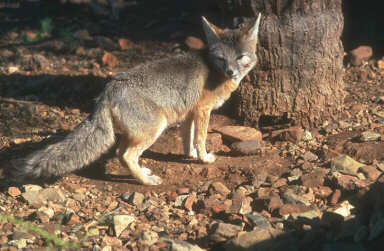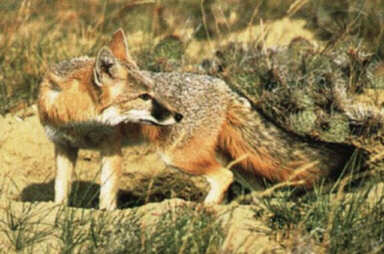
 |
| The kit fox, Vulpes macrotis. |
The kit fox and the swift fox are two closely related species. There has been considerable debate over whether or not they should be classified as a single species, a pair of subspecies, or separate species unto themselves. The kit foxes tend to be slightly smaller than the swifts, and show somewhat greater adaptation to desert environments. The kit fox has a narrower snout, a broader space between it´s eyes, larger ears, and a proportionately longer tail. The two species also tend to be clearly segregated into their respective geographic ranges. Nevertheless, the animals are quite similar to one another, and limited interbreeding between the two has been noted. One would expect that recent advances in DNA testing would resolve the issue, however in the preface to ´Red Fox - The Catlike Canine´ second edition, author J. David Henry points out this is not yet the case: ´...DNA fragment analysis supports splitting these foxes into two separate species, but morphometric and protein electophoretic research suggests lumping them together as one.´ This is cool scientific lingo for ´We haven´t decided yet.´ :)
The kit & swift foxes are small, graceful animals. Kits rarely exceed 1.8kg in mass while swifts range between 2-3kg. The swift fox has a body length of about 80cm of which it´s tail accounts for 28cm. It stands about 30cm at the shoulder. While being half its the size, the two species body proportions closely resemble those of the red fox´s. One exception is their ears, which are disproportionately large, an adaptation for regulating body temperature in the desert and arid prairie grasslands.
The kit & and swift foxes´ fur consists of a thick undercoat sparsely covered with longer guard hairs. The fur serves not only to keep the fox warm through cold nights but also insulates it from heat during the day. The soles of the kit fox´s feet are also covered with hair to protect them from hot desert sands. The coats are pale yellow-beige and grey to blend in with the desert grass. A pale underbelly, dark spots on either side of its nose, and a black tail tip are also characteristic. Like the arctic fox, the kit & swift foxes have heavily pigmented eyes to protect them from the sun´s glare.
 |
| The swift fox, Vulpes velox. |
True to its name, the swift fox is a fast, agile runner that appears all the more swift due to it´s small size.. Top speed has been estimated at between 40 and 60 km/h (kit foxes are slightly slower). While faster than most of their enemies, the foxes have less endurance than predators such as the coyote, and must therefore rely on their burrows for safety. The burrows also provide refuge from the desert´s heat during the day. Kit and swift foxes are primarily nocturnal, which further reduces exposure to heat and reduces water loss.
| Table of Contents |